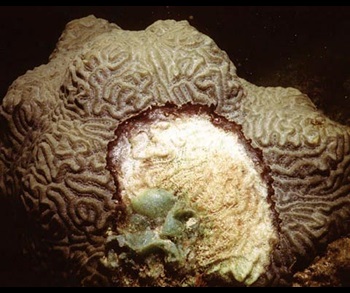A recent publication co-authored by Karin Ulstrup from DHI Australia looks into the virulence of disease in tropical corals. Even though coral diseases have been investigated for more than three decades, little is known about their causes and effects.
 Stony coral infected with the Black Band Disease
Stony coral infected with the Black Band Disease
(Source: Andy Bruckner, NOAA)
Coral diseases are particularly problematic in the Caribbean, where 80 per cent of corals have been lost to disease in the last 20 years. The current study was undertaken on the Great Barrier Reef, where some corals are prone to the so-called 'Black Band Disease'. The research, carried out in collaboration with Australian Institute of Marine Science and the German Max Planck Institute for Marine Microbiology, reveals that the high virulence of the Black Band Disease is triggered by the biochemical microenvironment caused by a consortium of microorganisms smothering the coral rather than by a specific pathogen. The higher the concentration of sulphide and the lower the oxygen levels become at the interphase between the black band and the coral tissue, the more dangerous the disease becomes.
"The outcome of our research suggests that fighting coral diseases may be more difficult than thought. It’s most probably not enough to identify a specific pathogen and fighting it with antibiotics", Karin Ulstrup explains.
Original article: Glas, MS, Sato, Y, Ulstrup, KE and Bourne, DG (2012): Biogeochemical conditions determine virulence of black band disease in corals. ISME Journal 2012, 1-9 (doi:10.1038/ismej.2012.2)